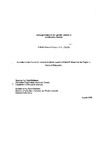lchthyophthiriasis in fish: genetic variation in resistance to infection
| dc.contributor.author | Clayton, Graham Maurice | |
| dc.contributor.other | School of Biological and Marine Sciences | en_US |
| dc.date.accessioned | 2013-10-25T11:51:24Z | |
| dc.date.available | 2013-10-25T11:51:24Z | |
| dc.date.issued | 1989 | |
| dc.identifier | NOT AVAILABLE | en_US |
| dc.identifier.uri | http://hdl.handle.net/10026.1/2382 | |
| dc.description.abstract |
The frequency and severity of fish diseases is; increasingly, being reported as a limiting factor in the future development of aquaculture. The control of fish disease is largely performed in retrospect through curative chemotherapy. However, the development of resistant strains of fish places the emphasis on preventative, rather than the curative, control of disease. The freshwater parasite Icthyophthirius multifiliis causes the disease known as ichthyophthiriasis or white spot. Losses of fish due to this parasite are believed to total over one million dollars per annum worldwide. The objective of this study was to examine the genetics of resistance to I. multifiliis, Comparisons were made between four stocks of the tropical livebearing fish Xiphophorus maculatus. One of these stocks, the blue platyfish, was found to be less susceptible to white spot than the yellow comet tail, red or red wag tail platyfish, Comparisons with four other tropical spades of fish found significant differences between X. maculatus, X. variatus, Ameca splendens and Ilyodon xanthusi in levels of susceptibility. A. splendens was the most susceptible species, with the blue platy (X. maculatus) and sunset platy (X. variatus) forming the most resistant group. All the remaining stocks and species formed an intermediate group. Examination of resistance to white spot infection in four scale types of related common carp (Cyprinus auratus) also found variation in resistance, with the fully scaled carp being the most resistant phenotype (scattered mirror, linear mirror and leather carp being similar in infection level). More detailed analysis of the genetics of disease resistance was performed with heritability determinations in stocks of A. splendens, X. maculatus (yellow comet tail) and X. maculatus (Vera Cruz). The highest heritability value, based on sire components only, was that for Vera Cruz platyfish of 0.75, with a value of 0.23 for X. maculatus (yellow comet tail) and 0.00 for A. splendens. A breeding programme was also performed between X. maculatus (red platy) and X. variatus (sunset platy) to evaluate the presence of any heterosis. Such was observed, with a heterosis value, based on actual parasite counts, of 16.2%. Several factors of the infection process are also discussed, especially the fluctuating yearly trends in infection levels and parasite strain differences. Finally, the future potential of genetic manipulation of fish stocks for increased disease resistance is discussed in the light of this study. It is considered that a useful foundation has been laid for the further development of this approach to disease prevention in aquaculture. | en_US |
| dc.description.sponsorship | Ministry of Agriculture, Fisheries and Food, Lowestoft Fisheries Laboratory | en_US |
| dc.language.iso | en | en_US |
| dc.publisher | University of Plymouth | en_US |
| dc.title | lchthyophthiriasis in fish: genetic variation in resistance to infection | en_US |
| dc.type | Thesis | |
| dc.identifier.doi | http://dx.doi.org/10.24382/4857 | |
| dc.identifier.doi | http://dx.doi.org/10.24382/4857 |
Files in this item
This item appears in the following Collection(s)
-
01 Research Theses Main Collection
Research Theses Main


